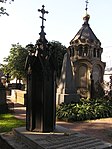Alexander Nevsky Square

Alexander Nevsky Square (Russian: Площадь Александра Невского, tr. Ploshchad Aleksandra Nevskogo), formerly called Red Square, is a city square in Tsentralny District, Saint Petersburg. It is at the east end of Nevsky Prospekt, linking the street with the Alexander Nevsky Lavra. Designed as part of the development of the monastery in the late eighteenth century, the square had received its name by at least 1784, and was laid out in the 1790s with the building of the Gate Church, and the establishment of a stone wall boundary. Several apartment buildings and an almshouse owned by the monastery were built fronting the square and Nevsky Prospekt. The alternative name Alexander Nevsky Lavra Square entered usage in the mid-nineteenth century. By the early twentieth century the square was considerably neglected and rundown. It was considered unsafe to walk through at night due to the likelihood of being robbed, while urban legends about voracious rats circulated. It was renamed Red Square in the early Soviet period, but reverted to Alexander Nevsky Square in 1952. The area was redeveloped in the 1960s with the completion of the Alexander Nevsky Bridge, and the opening of the Hotel Moscow and the metro station Ploshchad Alexandra Nevskogo. Another metro station, Ploshchad Alexandra Nevskogo-2, opened in the 1980s and in 2002 long-held plans for a monument to Alexander Nevsky came to fruition with the installation of a bronze equestrian sculpture in the square.
Excerpt from the Wikipedia article Alexander Nevsky Square (License: CC BY-SA 3.0, Authors, Images).Alexander Nevsky Square
площадь Александра Невского, Saint Petersburg Peski (округ Лиговка-Ямская)
Geographical coordinates (GPS) Address Nearby Places Show on map
Geographical coordinates (GPS)
| Latitude | Longitude |
|---|---|
| N 59.923611111111 ° | E 30.385277777778 ° |
Address
Александр Невский
площадь Александра Невского
193167 Saint Petersburg, Peski (округ Лиговка-Ямская)
Saint Petersburg, Russia
Open on Google Maps









